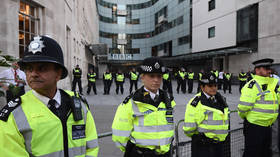NATO’s Defender Europe 20 exercises only increase chances of war with Russia, not diminish them
The upcoming US-led Defender Europe 20 military exercises – ostensibly designed to promote peace through deterrence – only increase the prospects of a deadly war with Russia on European soil.
This coming spring, the United States will deploy what it terms a “combat-capable” division-sized force from sites in the continental US to forward operating bases in Europe, where they will participate in exercises designed to counter hypothetical Russian military aggression.
Some 20,000 American servicemen and women will team up with 9,000 of their comrades already stationed in Europe, with some 13,000 pieces of equipment at their disposal – including tanks, armored fighting vehicles and artillery pieces – in the largest such effort since the US military stopped conducting the Return of Forces to Germany (Reforger) exercises at the end of the Cold War.
Codenamed Defender Europe 20, this exercise represents the culmination of over six years of work by the US military to rebuild offensive ground combat capability in Europe, which was lost when the last US heavy forces withdrew in 2013.
Following Crimea’s joining of Russia after a referendum in 2014, and the outbreak of separatist fighting in the Russian-speaking portions of eastern Ukraine, the US-led NATO alliance has been struggling to assemble a conventional military force capable of deterring possible Russian aggression against the Baltics and Poland. For its part, the US began rotating an armored brigade consisting of some 1,500 soldiers into Poland on a full-time basis, as well as deploying prepositioned stocks of military vehicles and equipment for additional forces that would be flown in. Defender Europe 20 represents the first full-scale exercise of this complete force.
Also on rt.com Avangard changes everything: What Russia’s hypersonic warhead deployment means for the global arms raceRussia’s response to NATO build-up
For its part, Russia has not been idle. After the collapse of the Soviet Union, the Russian Army underwent a major reorganization, standing down the massive armored formations that had been preparing for a war with NATO, and instead focusing on smaller, more agile formations conducive to regional security.
A major ground war in Europe no longer factored in Russian military thinking. This changed, however, once NATO began building up its forces in Poland and the Baltics. Russia reactivated the 1st Guards Tank Army and the 20th Guards Combined Arms Army, creating a powerful offensive mechanism designed to defeat any aggressive NATO moves into western Russia. Russian military forces in the exclave of Kaliningrad were likewise bolstered.
Following the demise of the INF Treaty in August of last year, a great deal of attention has been paid to the potential resumption of a new nuclear arms race in Europe. As a result, consideration of developments in conventional warfare capabilities tended to be suppressed in the mainstream media. But the fact is the enhancement of NATO’s conventional military response to Russian aggression – whether real or perceived – in eastern Europe and the Baltics through major exercises such as Defender-Europe 20 will inevitably lead to a larger Russian counter-response, resulting in an even greater build-up in conventional warfighting capability.
Also on rt.com ‘EU can’t defend Europe’: Stoltenberg takes aim at Macron’s ‘brain-dead’ NATOThere will be no winners, only losers
Europe has not witnessed a major ground war on its soil since the end of the Second World War in 1945, and when the Cold War ended in 1991, many experts believed that such a conflict was unimaginable in modern times. This thinking continues to this day, as the issue of nuclear re-armament looms large. The greatest threat to Europe, however, doesn’t come from nuclear weapons — the consequences of any nuclear conflict serve to make their use unimaginable.
The same does not hold true for conventional military capabilities. The ease with which the US and NATO project conventional military power toward Russia, and with which Russia prepares a conventional military counter-response, underscores the reality that conventional military force, unlike nuclear weapons, is relatively easy to deploy. The ugly truth of the matter is that the likelihood of conventional military power being unleashed as a result of a crisis in eastern Europe or the Baltics is very high.
The speed and lethality of modern weaponry means that any conventional conflict between NATO and Russia will be conducted with a level of sustained violence the likes of which the world has not witnessed in over 75 years. The casualties that will be inflicted on both sides are beyond the imagination of populations unfamiliar with the reality of modern war, as is the collateral damage to civilians caught in the middle. In short, the consequences of a conventional ground war in Europe will be massive amounts of death and destruction delivered across a broad swathe of territory in a very short time period.
Also on rt.com NATO’s attack on Kaliningrad could prompt Russia’s nuclear strikeThe US and NATO can talk all they want about how exercises such as Defender Europe 20 make Europe more stable and secure by giving teeth to the concept of a European deterrence to any potential Russian aggression. But there can be no deterrence if both sides are prepared to act in response to the actions of the other.
The fact is, Defender Europe 20 is but the latest in a series of aggressive moves by NATO — dating back to the expansion of the alliance into the territories of the former Warsaw Pact countries following the collapse of the Soviet Union — which have generated causal responses that make war with Russia more likely than not. If a war does break out, it will be the task of historians to apportion responsibility. But one thing is for certain: there will be no winners, only losers.
Like this story? Share it with a friend!
The statements, views and opinions expressed in this column are solely those of the author and do not necessarily represent those of RT.















